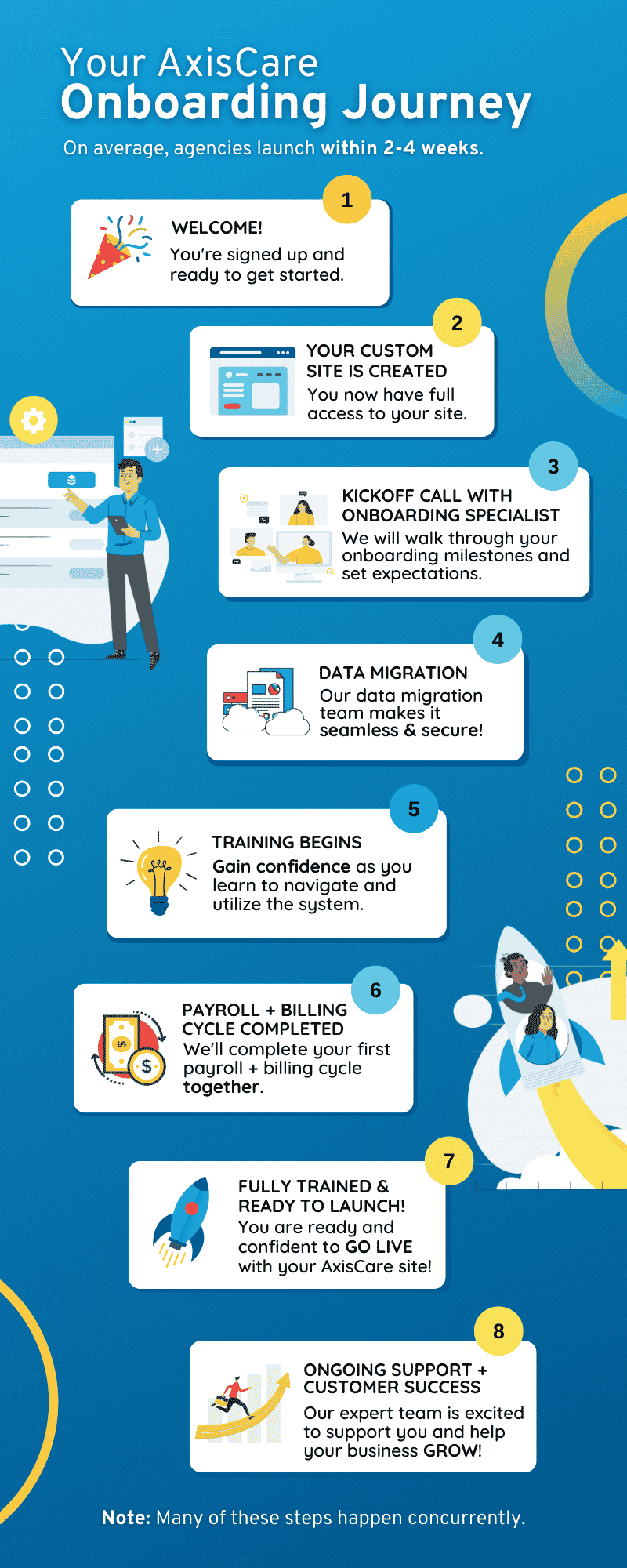Once limited to a privileged few, receiving support services at home has transformed in the modern era. With advancing technology becoming more accessible, home health care technology now holds a pivotal role. This shift marks the era of healthcare digitalization, reshaping the industry and our lifestyles. The digital transformation of healthcare at home has expanded access to medical services, making them more convenient and inclusive.
This blog delves into a detailed examination of technology’s impact on home health care, explaining how it streamlines medical procedures and enhances client care. Additionally, we will navigate through the challenges of integrating technological advancements into home health care and propose solutions to surmount them.
Key Features & Advantages of Home Care Software
Home care software represents a technological solution facilitating the management of home care services for clients, agencies, and caregivers. By streamlining operations, it enhances care quality, efficiency, and safety while fostering improved communication and collaboration among stakeholders. Additionally, it offers valuable data and insights to support home care businesses in thriving within the dynamic and competitive market landscape.
Below are some of the essential functionalities and advantages that home care software offers to various stakeholders:
Clients
Home care software empowers clients to receive personalized, high-quality care tailored to their needs and preferences, promoting improved health and well-being. Clients can communicate with caregivers, customize care plans, and make adjustments as needed. They can also Monitor and evaluate care delivery and outcomes, as well as provide feedback and reviews to caregivers and agencies, which are made easier through the software.
Moreover, home care software fosters clients’ independence and empowerment by providing tools to manage their care and health. For instance, clients can access health records, track vital signs and symptoms, and connect with family and friends through the software, enhancing their overall sense of control and well-being.
Caregivers
Home care software enhances caregivers’ effectiveness and efficiency while advancing their skills and knowledge. It provides convenient access to pertinent information like client profiles, care plans, instructions, checklists, and reminders. Additionally, it facilitates communication and coordination with clients and agencies, streamlining documentation and progress reporting.
Moreover, home care software supports caregivers in their professional development and career advancement. It offers training, certification, recognition, and rewards, empowering caregivers to acquire new skills, earn credentials, and receive feedback and ratings from both clients and agencies.
Home Care Agencies
Home care software aids in streamlining agency operations, including scheduling, billing, payroll, compliance, and reporting. It optimizes resource allocation, reduces expenses, and enhances efficiency by effectively matching caregivers with clients, minimizing errors, and automating routine tasks.
Furthermore, it supports client and caregiver retention by improving their experience. Through the software, agencies can offer personalized care plans, monitor care quality and outcomes, and facilitate feedback loops, fostering satisfaction and loyalty.
Understanding the Challenges
Advancements in the health sector hold significant potential for modern medicine and client care. According to Yahoo Finance, the estimated value of the global Home Healthcare Software market stood at $4.1 Billion in 2022. Projections indicate substantial growth, with the market anticipated to reach $11.8 Billion by 2030. This expansion, expected to occur at a CAGR of 14.2% during the analysis period spanning 2022-2030, underscores the increasing significance and adoption of home health care software worldwide.
However, despite the growing demand for at-home care and many advancements in home care software today, technological challenges persist.
Lack of Technological Proficiency Among Caregivers
New software solutions might be especially difficult for caregivers lacking the required technological knowledge. Many medical professionals and students majoring in nursing—especially those from older generations—may not be familiar with using digital technologies as part of their everyday routines. Slower acceptance rates and resistance to efficiently using online home care software can follow from this.
For those with majors in nursing, including technology in patient care is becoming more crucial. Through focused training and assistance, addressing this skill gap will enable caregivers to feel more confident and competent in using these technologies, enhancing the quality of the care provided.
An article published in Digital Health highlighted a prevalent lag in healthcare employees’ grasp of data analytics and their adaptation to emerging technologies in the UK. If doctors, nurses, and administrative staff lack sufficient training and knowledge in utilizing electronic health records or telehealth platforms, it can impede efficient healthcare delivery.
To tackle the issue of technological proficiency among caregivers, home health care organizations should prioritize investments in comprehensive training and educational initiatives. These programs should not only address the technical aspects of software utilization but also underscore the positive impact on client care and operational efficiency.
Resistance to Change in Traditional Workflows
Home care agencies often have established workflows and processes that have been in place for years. Introducing new software can disrupt these routines and lead to resistance from staff members who are comfortable with the status quo. Overcoming this resistance requires effective change management strategies to communicate the benefits of the software and address concerns.
Effective change management is critical for overcoming resistance to change in traditional workflows. Home health care leaders should communicate the reasons for adopting the software, involve staff members in the decision-making process, and provide ongoing support and guidance throughout the transition period.
Concerns Regarding Data Security & Privacy
With the increasing digitization of healthcare data, ensuring the security and privacy of client information is paramount. Home care software stores sensitive data, including medical records and personal details, making it a prime target for cyber threats. Data breaches not only compromise client confidentiality but also undermine trust in the home care provider.
Addressing concerns regarding data security and privacy requires implementing robust security measures and ensuring compliance with regulatory standards such as HIPAA. Home health care organizations should prioritize selecting home care software vendors that prioritize security and provide regular updates and patches to address vulnerabilities.
Data Migration
Data migration in home care software poses significant challenges, including compatibility issues, risks of data loss, operational downtime, compliance with security standards, and difficulties in user adoption. To mitigate these challenges, selecting a new software that supports easier data migration is crucial. Your new tool should include advanced data migration tools that simplify the mapping and transfer process, reducing errors and data loss. It should also offer compatibility features for integrating various data sources, robust testing and validation tools to maintain data integrity, and solutions to minimize downtime during migration. Additionally, these systems must come with comprehensive training and support resources to facilitate smoother transition and enhance user adoption.
Compatibility Issues With Existing Systems
The seamless integration of online home care software with existing systems and workflows is vital for its successful adoption. Nevertheless, compatibility issues between different software platforms can pose challenges.
To overcome compatibility issues with existing systems, home care agencies should prioritize selecting software solutions that offer seamless integration capabilities. Open APIs and interoperability standards can facilitate data exchange between different software platforms, ensuring smooth workflow transitions.
Future Trends & Innovations
Home care software solutions need to continuously adapt to the evolving needs and expectations of the home care market, as well as the emerging trends and technologies shaping its future. Innovation can address the challenges of home care, but it requires significant investments in research, development, testing, and validation, as well as collaboration and partnerships with other stakeholders and experts. It is crucial for home care software solutions to stay ahead of the curve by embracing new technologies and incorporating them effectively to meet the evolving needs of caregivers and clients alike.
Embracing Home Care Software for Improved Home Care Services
While the adoption of home care software presents its own set of challenges, overcoming these obstacles is essential for realizing the full potential of these digital tools in improving client care and streamlining operations. Book a demo with AxisCare to experience firsthand how our software can pave the way for improved operational efficiency at your agency, empowering you to adapt to the evolving needs of your clients.









